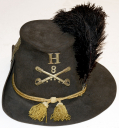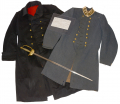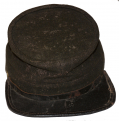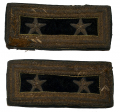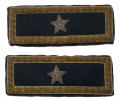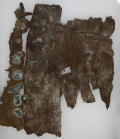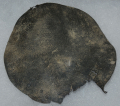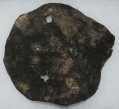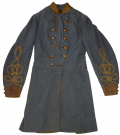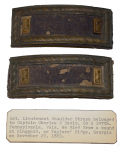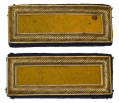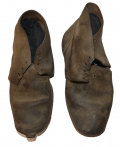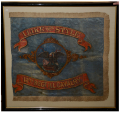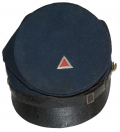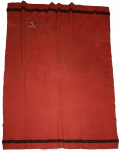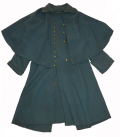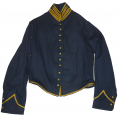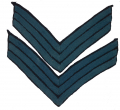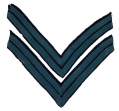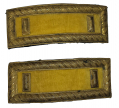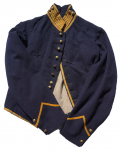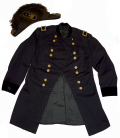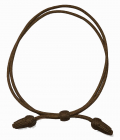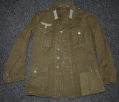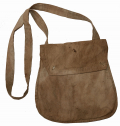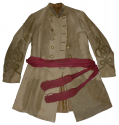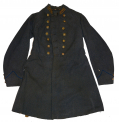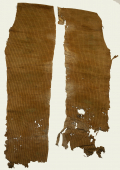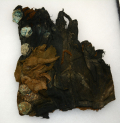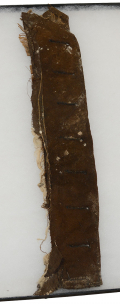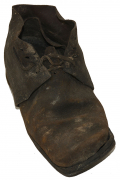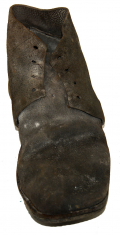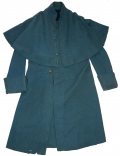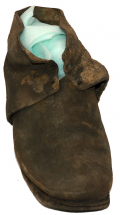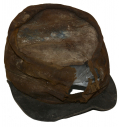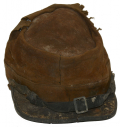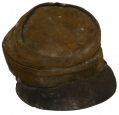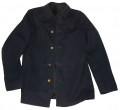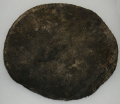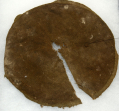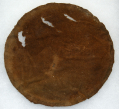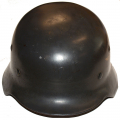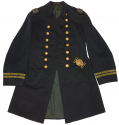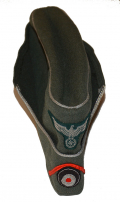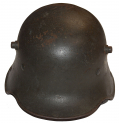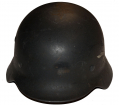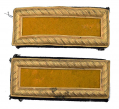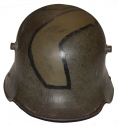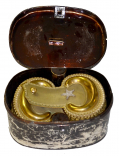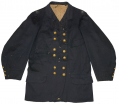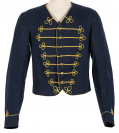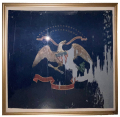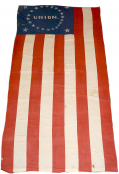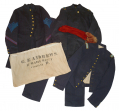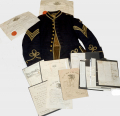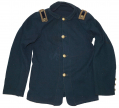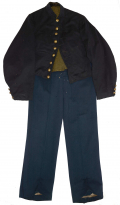site search
online catalog
Uniforms & Cloth
Showing 1 to 194 out of 194
US CAVALRY M1858 DRESS “HARDEE” HAT – 8th REGIMENT, COMPANY H
The M1858 Dress Hat was the formal counterpart to the fatigue duty headwear of the US Army. Made of stiff black felt, the hat found little favor among Civil War servicemen, particularly in the east,… (1268-775). Learn More »
ID’D US FROCK COAT AND FORAGE CAP – CORPORAL ALFRED CARPENTER, 44th MASSACHUSETTS (EX-TEXAS MUSEUM COLLECTION)
The 44th Massachusetts was born of the 4th Battalion of Massachusetts Volunteer Militia, a unit formed at the outset of the American Revolution which called itself the “New England Guards”. … (1268-266). Learn More »
$14,950.00
SOLD
ZOUAVE FIRST SERGEANT CHEVRONS
These chevrons measure about 8 inches wide and 4 inches tall and use a red ground with three narrow, sewn, medium blue stripes and a diamond/lozenge, indicating a First Sergeant, the senior… (490-7153). Learn More »
NINTH MASSACHUSETTS ARTILLERY " GETTYSBURG RETREAT BY RECOIL" CAP
This forage cap of the "McDowell" style was picked up immediately following the Battle of Gettysburg and subsequently resided in a Massachusetts GAR hall for over 60 years. Its importance cannot be… (1284-01). Learn More »
$9,650.00
SOLD
THE HISTORICALLY SIGNIFICANT UNIFORM AND SWORD GROUPING OF BRIGADIER GENERAL EPPA HUNTON CSA
Eppa Hunton was born near Warrenton, Virginia on September 24, 1822. After graduating from the New Baltimore Academy, he taught school for three years, then studied law and was admitted to the bar in… (2025-295). Learn More »
SMITH PATENT SECOND LIEUTENANT OF ARTILLERY SHOULDER STRAPS
Military goods dealer James S. Smith of New York patented this form of shoulder strap on June 18, 1861. They used a gilt brass frame stamped to imitate dead and bright bullion embroidered borders and… (142-110). Learn More »
EXCELLENT CONDITION SMITH PATENT BRIGADIER GENERAL’S SHOULDER STRAPS
Smith patent shoulder straps used a gilt stamped brass border imitating the dead and bright bullion of embroidered shoulder straps, and were more robust, easier to maintain and less expensive, making… (142-111). Learn More »
CONFEDERATE DEEP SOUTH DEPOT ENLISTEDMAN'S KEPI
Federal soldier George Wilson, 21st Missouri Infantry (US), captured this cap at the Fort Blakely fight near Mobile, Alabama April 9th, 1865. The cap appears to have been mass produced at a clothing… (2025-300). Learn More »
$16,500.00
ON HOLD
TRIPLE-BORDERED BULLION EMBROIDERED MAJOR GENERAL’S SHOULDER STRAPS OF ABNER DOUBLEDAY: LED THE FIRST CORPS AFTER REYNOLD’S DEATH ON JULY 1
Once in the personal collection of renowned military artist and historian Don Troiani, these major-general’s straps were worn by General Abner Doubleday. They are in good condition, showing some use… (1255-02). Learn More »
$6,950.00
SOLD
BRIGADIER GENERAL’S SHOULDER STRAPS
A very nice condition pair of Civil War period Brigadier General’s shoulder straps showing signs of actually having been worn on a uniform. These measure 1-1/2” wide by 3-7/8” long and are… (2025-278). Learn More »
PIECE OF AN INDIAN WAR M1872 FATIGUE BLOUSE FROM FORT PEMBINA, ND
This is a portion of a rare Model 1872 fatigue blouse clearly showing the characteristic pleats of the pattern. These were replacements for the old Civil War M1858 fatigue blouse (the 4-button sack… (1052-579). Learn More »
PIECE OF AN INDIAN WAR M1872 FATIGUE BLOUSE FROM FORT PEMBINA, ND
This is a portion of the rare Model 1872 fatigue blouse. The pattern was a replacement for the old Civil War M1858 fatigue blouse (the 4-button sack coat,) made with the idea of giving the soldier… (1052-578). Learn More »
KEPI OR DRESS CAP STIFFENER FROM FORT PEMBINA
This comes from the excavations at Fort Pembina, ND, a small frontier army post in operation from 1870 to 1895, and is the stiffener from inside the top of a kepi a M1872 dress cap. It is black in… (1052-1152). Learn More »
KEPI OR DRESS CAP STIFFENER FROM FORT PEMBINA
This comes from the excavations at Fort Pembina, ND, a small frontier army post in operation from 1870 to 1895, and is the stiffener from inside the top of a kepi a M1872 dress cap. It is black in… (1052-475). Learn More »
24th MICHIGAN IRON BRIGADE LT. COLONEL MARK FLANIGAN’S HARDEE HAT INSIGNIA WITH HIS LT. COLONEL AND BREVET BRIG. GENERAL SHOULDER STRAPS: WOUNDED AT GETTYSBURG
“Lieutenant-Colonel Flanigan lost his leg in this battle. His conduct here, as everywhere in battle, was gallant and daring.” So wrote Colonel Henry Morrow of the 24th Michigan in his official… (1255-01). Learn More »
IDENTIFIED CONFEDERATE CAPTAIN’S FROCK COAT OF CAPT. ANDREW J. EHEART, 13th VIRGINIA INFANTRY, TWICE WOUNDED, KILLED AT SPOTTSYLVANIA
This regulation Confederate Captain’s frock coat was worn by Capt. Andrew Jackson Eheart Company F, 13th Virginia, twice wounded in action in 1862 and killed in action at Spottsylvania in 1864. The… (846-565). Learn More »
INDIAN WARS MOUNTED SERVICES GREATCOAT WITH NEW YORK BUTTONS AND MAKER MARKINGS
This unique military overcoat is of the post-Civil War Indian Wars period and features a unique pattern with New York State appointments. The piece seems to be something of a hybrid between the m1858… (490-7149). Learn More »
BOOK – THE BATTLE FLAGS OF THE CONFEDERATE ARMY OF TENNESSEE
By Howard Madaus & Robert Needham, published by the Milwaukee Public Museum in 1976. Soft cover, perfect bound, 152 pages, 8.5” x 11”. Heavily illustrated with line drawings of which some are… (1266-1055). Learn More »
PAIR OF SMITH PATENT 1ST LIEUTENANT SHOULDER STRAPS ATTRIBUTED TO 147TH PENNSYLVANIA OFFICER
Straps have the usual convex stamped brass false embroidered single border. The surfaces of each have a nice patina. The blue wool rank field has faded to a purple color. One strap has a fair amount… (33-347). Learn More »
$480.00
Originally $650.00
PAIR OF SMITH PATENT 2ND LIEUTENANT OF CAVALRY SHOULDER STRAPS
Straps have the usual Smith patent false embroidered stamped brass border. The yellow wool of the rank field still has strong color but both show light wear. One shows some small moth nips while the… (33-343). Learn More »
$550.00
Originally $750.00
PIECE OF A U.S. FLAG FROM THE FRONTIER US ARMY FORT PEMBINA, NORTH DAKOTA
This piece of bunting comes from excavations at Fort Pembina, ND, conducted on private property with the owner’s permission, a fort established in 1870 by troops of the 20th US Infantry and… (1052-722). Learn More »
PIECE OF CIVIL WAR - INDIAN WAR FRONTIER US ARMY BLANKET FROM FORT PEMBINA, NORTH DAKOTA
This piece of a US Army military issue blanket comes from excavations at Fort Pembina, ND, conducted on private property with the owner’s permission, a fort established in 1870 by troops of the 20th… (1052-615). Learn More »
US ARMY SHIRT CUFF FROM FORT PEMBINA, NORTH DAKOTA
A relic from a small U.S. Army frontier post of the Indian Wars- part of a soldier’s shirt. This is the shirt cuff, still showing a small button near the corner, and a portion of the lower sleeve.… (1052-602). Learn More »
REMNANT OF SCARCE INDIAN WAR SOLDIER’S MITTEN FROM FORT PEMBINA, ND
This comes from the excavations at Fort Pembina, occupied 1870-1895, where cold weather in winter months might well be a concern. The army began issuing mittens in 1873. Before that men were left to… (1052-584). Learn More »
WELL-WORN CIVIL WAR BROGANS
Officially known as the M1851 Jefferson Bootee, the simple but rugged “brogan” was the standard issue shoe for both US and CS forces during the Civil War. They have a medium rise upper with four… (1268-019). Learn More »
KEPI CHINSTRAP AND SIDE BUTTONS FROM AN INDIAN WAR FRONTIER
This is a complete leather chinstrap from an army kepi or forage cap from excavations at Fort Pembina, ND. The chinstrap is a two-piece style with a fixed loop on the end of one strap and a fixed… (1052-486). Learn More »
CIVIL WAR-INDIAN WAR UNIFORM COAT PIECE WITH BUTTON FROM FORT PEMBINA
This is part of the right lapel of a US army coat discarded by a soldier at Fort Pembina, ND, sometime between 1870 and 1895, and is from excavations in wet, anaerobic soil that has preserved leather… (1052-724). Learn More »
PIECE OF US ARMY BLANKET FROM FORT PEMBINA, NORTH DAKOTA
This piece of a US Army military issue blanket comes from excavations at Fort Pembina, ND, conducted on private property with the owner’s permission, a fort established in 1870 by troops of the 20th… (1052-616). Learn More »
REGIMENTAL STANDARD OF MERRILL’S HORSE, 2ND MISSOURI CAVALRY
Formerly in the collections of the Texas Civil War Museum, this historic flag was carried by Merrill’s Horse, the 2nd Missouri Cavalry, raised under the authority of Gen. John C. Fremont, commanding… (1179-031). Learn More »
$22,500.00
Originally $30,000.00
ON HOLD
MAKER MARKED AMERICAN MILITARY OFFICER’S CHAPEAU CA. 1825-1835
This scarce American military officer’s chapeau has a largely intact white silk lining bearing a black maker’s stamp reading “C. St. JOHN. / 118 / BROADWAY, New York.” Bazelon places Charles… (413-01). Learn More »
$1,750.00
Originally $2,450.00
1863 PATTERN US CAVALRY GUIDON FROM THE 1st CONNECTICUT CAVALRY
This cavalry guidon was formerly in the personal collection of Jim Stamatelos, well known Civil War collector, dealer, and major contributor of items illustrated in the Time-Life volume “Echoes of… (433-14). Learn More »
PIECE OF AN INDIAN WAR M1872 FATIGUE BLOUSE OR DRESS COAT FROM FORT PEMBINA, ND
This is a piece from the lapel of a US Army jacket showing part of the blue outer fabric, the lining and the remains of five corroded brass buttons. From the size and spacing of the buttons this is… (1052-608). Learn More »
PIECE OF CIVIL WAR ARMY BLANKET FROM FORT PEMBINA, NORTH DAKOTA
The army had vast stocks of Civil War material left over at the end of the war. These supplies, along with the reduction of the postwar army meant U.S. troops were getting Civil War gear well into the… (1052-617). Learn More »
SCARCE INDIAN WAR SOLDIER’S MITTEN FROM FORT PEMBINA, ND
This comes from the excavations at Fort Pembina, occupied 1870-1895, where cold weather in winter months might well be a concern. The army began issuing mittens in 1873. Before that men were left to… (1052-620). Learn More »
INDIAN WAR SOLDIER’S MITTEN FROM FORT PEMBINA, ND
This comes from the excavations at Fort Pembina, occupied 1870-1895, where cold weather in winter months might well be a concern. The army began issuing mittens in 1873. Before that men were left to… (1052-619). Learn More »
FLY FROM INDIAN WAR SOLDIER’S TROUSERS, FORT PEMBINA, ND
This comes from the excavations at Fort Pembina, occupied 1870-1895, where the wet, anaerobic soil conditions of the dig (conducted on private property with the owner’s permission,) have yielded… (1052-599). Learn More »
$65.00
ON HOLD
WONDERFUL CONDITION ORIGINAL CONFEDERATE-MANUFACTURED KEPI FOR A DRUMMER BOY OR CHILD
This article of uniform clothing is an original, Civil War example of headgear manufactured in the Confederacy and presented here in wonderful, original intact condition. The period artifact is a… (526-68). Learn More »
$4,750.00
Originally $6,500.00
7TH ARMY CORPS FLAG FOR G.A.R. HALL OR ENCAMPMENT USE
Measures 18 ½” x 25”, circa 1890-1900. The corps badge design is two-sided, sewn on with two rows of zig-zag stitching. There is also an inner accent stitching. Overall condition is fine, with… (399-18). Learn More »
$175.00
Originally $250.00
13-STAR CONFEDERATE FIRST NATIONAL FLAG WITH GETTYSBURG HISTORY - “GRIMES COUNTY GREYS,” CO. G, 4th TEXAS INFANTRY, HOOD’S TEXAS BRIGADE
The flag is in very good condition, with strong colors and just a few scattered small holes that do not detract. It has been archivally conserved, mounted and framed by Textile Preservation Associates… (1179-1393). Learn More »
“I LIKE YOUR STYLE” THE REGIMENTAL STANDARD OF THE 12th ILLINOIS CAVALRY: GAMBLE’S BRIGADE UNDER BUFORD ON JULY 1 AT GETTYSBURG
We can’t think of a more flamboyant, devil-may-care motto on a cavalry standard than this one, whose overtly casual nature no doubt intentionally contrasts with their combat and fighting record.… (1179-033). Learn More »
FIRST NATIONAL CONFEDERATE FLAG OF THE RED RIVER VOLUNTEERS, CO. E 11th TEXAS CAVALRY
This eleven-star First National Confederate Flag was sewn by Mrs. Isabella (“Ibbie”) Haddon Hopkins Gordon of Clarksville, Texas, and presented to the “Red River Volunteers,” later Company E… (1179-1396). Learn More »
FINE PAIR OF RED EPAULETTES
Pair of red wool epaulettes with “eagle A” buttons. Epaulette outer-surfaces feature beautiful, woven red wool with a ribbed border, and thick rows of hanging tassels. A single eagle “A”… (1179-1652). Learn More »
PIECE OF INDIAN MADE ROPE FROM PLANT MATERIAL FROM FORT PEMBINA, NORTH DAKOTA
This is a short section of rope made from twisted and woven plant fibers and comes from excavations at Fort Pembina, ND, conducted on private property with the owner’s permission, a fort established… (1052-720). Learn More »
CIVIL WAR-INDIAN WAR UNIFORM LAPEL FROM FORT PEMBINA
This strip of cloth showing three buttonholes (and what seems to be part of a fourth) is the remnant of an army dress coat discarded after its useful days were done at Fort Pembina, a small frontier… (1052-610). Learn More »
INDIAN WAR SOLDIER’S MITTEN PIECE FROM FORT PEMBINA, ND
This comes from the excavations at Fort Pembina, occupied 1870-1895, where cold weather in winter months might well be a concern. The army began issuing mittens in 1873. Before that men were left to… (1052-621). Learn More »
CIVIL WAR-INDIAN WAR FORAGE CAP VISOR
This is a well preserved leather visor from a forage cap recovered at Fort Pembina, ND, where it was preserved in remarkable condition by wet, anaerobic soil conditions. This is typical of the simple… (1052-485). Learn More »
CIVIL WAR-INDIAN WAR FORAGE CAP VISOR
This is a well preserved leather visor from a forage cap recovered at Fort Pembina, ND, where it was preserved in remarkable condition by wet, anaerobic soil conditions. This is typical of the simple… (1052-482). Learn More »
CIVIL WAR-INDIAN WAR FORAGE CAP VISOR
This is a well preserved leather visor from a forage cap recovered at Fort Pembina, ND, where it was preserved in remarkable condition by wet, anaerobic soil conditions. This is typical of the simple… (1052-481). Learn More »
$45.00
ON HOLD
EXCELLENT PAIR OF US BOOTEES/BROGANS
This original pair of standard issue Jefferson Booties, often called “Brogans”, come to us in a virtually pristine condition relative to their age and materials of composition. Showing no signs of… (490-7151). Learn More »
CIVIL WAR BUMMER OR FORAGE CAP WITH NINTH CORPS BADGE
This is an excellent example of an original Civil War Union army regulation Model 1858 Forage Cap with a Ninth Corps badge on top, displaying the cross cannon and fouled anchor reflecting the origins… (1052-143). Learn More »
$4,000.00
Originally $4,500.00
COMMERCIAL, PRIVATE PURCHASE, CIVIL WAR BUMMER CAP WITH CORPS BADGE
Officers had to buy their own uniforms and headgear, but NCOs and even privates might occasionally also purchase a cap following the general lines of the government issue, but of better quality, more… (1052-202). Learn More »
$3,500.00
Originally $3,950.00
CIVIL FORAGE CAP BY MURPHY AND GRISWOLD WITH 14th CORPS BADGE
Thomas Murphy, William Griswold & Company were hatters on 19th Street in New York City and had major contracts for caps and hats with the U.S. government from 1862 to 1865, with the firm changing… (1052-227). Learn More »
$3,700.00
Originally $4,250.00
MCDOWELL PATTERN FORAGE CAP WITH FOURTH ARMY CORPS BADGE
This is a great example of the “McDowell” style cap popularized early in the war by General Irwin McDowell (1818-1835,) who was perhaps a bit more inspiring in haberdashery than generalship. The… (1052-146). Learn More »
$3,700.00
Originally $4,250.00
CIVIL WAR COMMERCIAL FORAGE CAP WITH MAINE BUTTONS AND ASSOCIATED INSIGNIA
Commercial caps were simply those purchased privately rather the issued by the government. They might more or less closely follow contract patterns with the purchaser able to suit his taste and… (1052-139). Learn More »
$4,000.00
Originally $4,500.00
IDENTIFIED ISSUE RED BLANKET OF THEODORE P. BOWKER 13th MASSACHUSETTS - DIED OF WOUNDS AT ANTIETAM!
This is a rare, early-war, identified Massachusetts issue red blanket carried by a soldier in the 13th Massachusetts who was wounded at Antietam on Sept. 17, 1862, and died of those wounds at a U.S.… (490-7138). Learn More »
$6,500.00
Originally $7,500.00
SUPERB, RARE MOUNTED SERVICE GREATCOAT
This style of cold weather coat is among those which replaced the long-standing model 1819/32 overcoat in favor of the US model 1851 style, the primary overcoat utilized by US army during civil war.… (490-7134). Learn More »
EXCELLENT CONDITION US CAVALRY SHELL JACKET
The body of this jacket is in excellent condition. There is no visible moth damage of any kind. All the piping is present and is bright. Both pillows are present on the back and are also in great… (490-7133). Learn More »
EXCELLENT CIVIL WAR FEDERAL SERGEANT CHEVRONS
This is an excellent pair of Civil War infantry chevrons. These are made of light blue worsted wool stripes sewn to a dark blue wool background patch, which in turn would be sewn to the sleeve of the… (490-7164). Learn More »
EXCELLENT PAIR OF CIVIL WAR FEDERAL INFANTRY REGULATION CORPORAL CHEVRONS/STRIPES
Union infantry companies fielded eight corporals. Along with the sergeants they might be charged with supervising squads or fatigue details, but in battle were posted in the front rank of the line of… (490-7163). Learn More »
RARE CONFEDERATE CAVALRY GUIDON
This Confederate guidon comes from the collections of the Texas Civil War Museum. The flag has been professionally conserved, matted, and framed by Textile Preservation Associates and comes with their… (1179-027A). Learn More »
EXCELLENT CONDITION, SCARCE SMITH PATENT CAVALRY FIRST LIEUTENANT STRAPS
Cavalry shoulder straps combine strong eye appeal from the yellow branch of service color with the romance associated with the mounted forces and are also scarce by comparison with infantry straps… (2024-1277). Learn More »
VERY LARGE US CIVIL WAR 34 STAR FLAG
The United States only used the 34-star flag from July 4, 1861 to July 3, 1863. This flag is entirely handmade of cotton bunting and meas. approx. 8.00 feet long on the hoist by 15.00 feet long on the… (766-1931). Learn More »
UNION CAVALRY SHELL JACKET
The m1858 Mounted Services Jacket - trimmed in yellow - was ubiquitous among Federal Cavalry Troopers during the Civil War and into the West as a standard issue item. One of the war’s most… (2024-1844). Learn More »
$1,895.00
ON HOLD
MINT IDENTIFIED BREVET BRIGADIER GENERAL’S FROCK COAT AND CHAPEAU OF ALONZO ALDEN
This sets consists of Brevet Brigadier General Alonzo Alden’s mint condition brigadier general’s frock coat with shoulder straps and his full dress “light French chapeau,” allowed for officers… (1179-156). Learn More »
OFFICER’S GOLD TONE HAT CORD, ID’D TO COL. WILLIAMS, 9TH PA. CAVALRY
woven gold bullion cord, adjuster slide, and acorns. All in very fine condition. This has a verbal identification to Colonel Edward Williams, 9th Pennsylvania Cavalry. Author/historian Randy… (1256-108). Learn More »
5th NEW YORK NATIONAL GUARD COMPANY E FLANK MARKER
This very attractive blue silk marker with gold fringe and embroidered unit designation comes with a 1995 letter from flag authority Howard Madaus, a 2004 treatment report by Textile Preservation… (1179-014). Learn More »
WWII JAPANESE LEG WRAPS (PUTTEES)
Wraps and ties do not look to haven been shortened and there is a good amount of use war to them. There is a good bit of fraying on the edges of the wraps and the end of the ties. There is a white tag… (1235-258). Learn More »
WWII GERMAN AFRIKA CORPS TUNIC
Tunic shows little wear from use. There is an approx. 1 ½” tear in the lapel on the right side. One cuff button on the left side is missing. The collar tabs are machine sewn down and the eagle is… (1235-453). Learn More »
EXCELLENT CONDITION UNION ARTILLERY SHELL JACKET
Standard issue dark blue wool shell jacket with red piping on collar and cuffs with red trim down the front and along the edges. Jacket has 12 General Service eagle buttons down the front with two… (1179-160). Learn More »
WORLD CLASS IDENTIFIED WOUNDED IN ACTION CIVIL WAR NORTH CAROLINA SOLDIER’S JACKET WITH BULLET HOLE FROM HIS WOUND AT THE WILDERNESS!
Formerly in the collections of the Texas Civil War Museum this world-class Confederate infantryman’s jacket worn by William B. Royal came directly out of the family in 2002, having been previously… (814-69). Learn More »
MASSACHUSETTS HAVERSACK
These smaller white canvas haversacks fastening with two bone buttons usually show up marked with an ink stamp as “inspected and accepted” by Massachusetts. This one was most likely so marked as… (2024-1382). Learn More »
WWII GERMAN WINTER MITTENS
Mittens show little age and use wear. The string to hang them around your neck is still attached. The markings are on the white side and are a little blurry. The insides are feldrgrau [green grey]… (1235-152). Learn More »
EXCEEDINGLY RARE CIVIL WAR US CAVALRY TROUSERS
This is a wonderful pair of regulation Civil War US issue enlisted cavalryman’s trousers that are incredibly rare and in great condition. They are made of sky-blue kersey with waistband and pockets… (2024-1285). Learn More »
CONFEDERATE CAVALRY CAPTAIN’S FROCK COAT OF CAPT. EDWARD BIRD, “EFFINGHAM HUSSARS,” 2nd BATTALION AND 5th REGIMENT GEORGIA CAVALRY
This rare, identified, Confederate cavalry captain’s frock coat belonged to an officer who served from 1861 though 1865, rising from Captain to Colonel, with extensive action especially in… (1179-232). Learn More »
IDENTIFIED CONFEDERATE CAPTAIN’S FROCK COAT OF CAPTAIN PHARES WALDO SHEARER, 45th MISSISSIPPI, WITH 28-PAGE REMINSCENCES AND VETERAN’S BADGE- HE EXCHANGED SALUTES WITH THE WOUNDED JOHN BELL HOOD AT CHICKAMAUGA
This coat came directly out of the family along with a reunion badge and type-written copy of the officer’s 1906 reminiscences. The coat was formerly in the collection of Steve Mullinax, is… (1179-179). Learn More »
DOUBLE-DECAL WW2 LUFTWAFFE HELMET
Very good WW2 German luftwaffe helmet complete with liner and chinstrap. Better than 90 percent paint. Scratches to the national decal on the right as shown and rubbing to the eagle’s wingtips on… (169-685). Learn More »
$2,475.00
ON HOLD
CIVIL WAR-INDIAN WAR FORAGE CAP VISOR
This is a well preserved leather visor from a forage cap recovered at Fort Pembina, ND, where it was preserved in remarkable condition by wet, anaerobic soil conditions. This is typical of the simple… (1052-480). Learn More »
CIVIL WAR-INDIAN WAR FORAGE CAP VISOR
This is a well preserved leather visor from a forage cap recovered at Fort Pembina, ND, where it was preserved in remarkable condition by wet, anaerobic soil conditions. This is typical of the simple… (1052-483). Learn More »
FIRST WORLD WAR US M1917 HELMET WITH 78TH DIVISION INSIGNIA
This is a US made M1917 steel helmet used by a member of the 78th Infantry Division. Nearly identical to the British army helmet, the M1917 and later the M1917A1 were used up to the Second World War,… (490-6909). Learn More »
US NAVY SEAMAN’S DUFFEL BAG WITH EAGLE AND NAME
This seaman’s duffel bag, measuring about 23’ by 12 ½” when laid flat, was intended for personal clothing, etc., and has been personalized with a stenciled American eagle with outstretched… (1179-593). Learn More »
SCARCE CIVIL WAR ARMY ISSUE SHOE, A.K.A. BROGAN OR BOOTTEE
This Civil War US army issue shoe is typical wartime construction, using rough-side out black leather with reinforcing heel piece or “counter” sewn inside, four pairs of holes for a leather lace,… (1052-282). Learn More »
KNIT DRAWERS OR TROUSERS FROM FORT PEMBINA
These pieces are two legs from trousers or, more likely, drawers recovered in the excavations at Fort Pembina, ND, conducted on private property with the owner’s permission, where wet, anaerobic… (1052-446). Learn More »
CIVIL WAR-INDIAN WAR UNIFORM COAT PIECE WITH BUTTONS FROM FORT PEMBINA
This comes from the right lapel of a US army coat discarded by a soldier at Fort Pembina, ND, sometime between 1870 and 1895, and is from excavations in wet, anaerobic soil that has preserved leather… (1052-580). Learn More »
INDIAN WAR FIELD-USED CAMPAIGN HAT FROM FORT PEMBINA, NORTH DAKOTA
This is a real field-used Indian War campaign hat in relic condition excavated at Fort Pembina, ND, a small frontier army post in operation from 1870 to 1895. Anaerobic conditions of the dig have… (1052-253). Learn More »
US ARMY DRESS COAT LAPEL FROM FORT PEMBINA, ND
This coat lapel comes from the left side of US army dress coat discarded by a soldier at Fort Pembina, ND, and was excavated in wet, anaerobic soil that has preserved leather and cloth in remarkable… (1052-589). Learn More »
SCARCE CIVIL WAR ARMY ISSUE SHOE MADE AND MARKED BY CIVIL WAR CONTRACTOR JOHN MUNDELL OF PHILADELPHIA
This is a typical, though very scarce, Civil War issue army shoe made by a known contractor and marked by him on the inside of the ankle: “J. MUNDELL.” Mundell was born in Ireland in 1829, reached… (1052-298). Learn More »
SCARCE CIVIL WAR ARMY ISSUE SHOE, A.K.A. BROGAN OR BOOTTEE
This Civil War US army issue shoe is typical wartime construction, using rough-side out black leather with reinforcing heel piece or “counter” sewn inside, four pairs of holes for a leather lace… (1052-285). Learn More »
SINGLE SHOULDER STRAP FOR A CAPTAIN OF STAFF
Strap is made of dark blue cloth with a double row of dead bullion for a border. The rank field is of black velvet while the rank of captain is made of bars of heavy gold bullion thread. The underside… (460-1468). Learn More »
CIVIL WAR SOLDIER-MODIFIED SCHUYLKILL ARSENAL INFANTRY OVERCOAT
Once in the famed collection of John Henry Kurtz, this regulation Civil War sky-blue infantry overcoat (or greatcoat) is complete, all original, in very good condition and shows a wonderful field… (1235-05). Learn More »
SCARCE CIVIL WAR ARMY ISSUE SHOE, A.K.A. BROGAN OR BOOTTEE
This Civil War US army issue shoe is typical wartime construction, using rough-side out black leather with reinforcing heel piece or “counter” sewn inside, four pairs of holes for a leather lace… (1052-300). Learn More »
REGULAR ARMY CIVIL WAR ENLISTED KEPI WITH INDIAN WAR USE FROM FORT PEMBINA, NORTH DAKOTA
This Civil War enlisted man’s kepi comes from excavations at Fort Pembina, ND, conducted on private property with the owner’s permission. The fort was established in 1870 by troops of the 20th US… (1052-250). Learn More »
REGULAR ARMY CIVIL WAR ENLISTED KEPI WITH INDIAN WAR USE FROM FORT PEMBINA, NORTH DAKOTA
This Civil War enlisted man’s kepi comes from the excavations at Fort Pembina, ND, conducted on private property with the owner’s permission, and is in a remarkable state of preservation from the… (1052-252). Learn More »
REGULAR ARMY MODEL 1872 KEPI FROM FORT PEMBINA, NORTH DAKOTA
This Model 1872 officer’s kepi comes from excavations at Fort Pembina, ND, conducted on private property with the owner’s permission. The fort was established in 1870 by troops of the 20th US… (1052-248). Learn More »
INDIAN WAR ARMY SHOES BY MUNDELL FROM FORT PEMBINA, ND
This pair of shoes is from the excavations at Fort Pembina, ND, and could be taken for attic or barn-finds, having been preserved by the wet, anaerobic soil conditions of the dig. They are solid, can… (1052-387). Learn More »
1890 FATIGUE BLOUSE
This 5-button blouse has four coat size Civil War eagle buttons on the front and two smaller Civil War eagles on each cuff. The generous among us take this as a nice bonus; the cynical think someone… (1235-28). Learn More »
INDIAN WAR FIELD-USED CAMPAIGN HAT MADE FROM A CIVIL HARDEE HAT
This is a real field-used example of an Indian War US Army campaign hat made from a Civil War M1858 issue dress hat (the “Hardee” or “Jeff Davis” hat) that comes from the excavations at Fort… (1052-245). Learn More »
US INSPECTED ARMY SHOE FROM FORT PEMBINA, ND
This soldier’s shoe bears a partially visible stamp inside reading “INSPECTOR / NEW YORK,” indicating it is government issue and appears to be one of the experimental patterns of footwear tried… (1052-386A). Learn More »
ARMY SHOE FROM FORT PEMBINA, ND
This soldier’s shoe is very similar to another found in the Fort Pembina excavations that has a partially visible US inspector’s mark and in construction differs only in having four sets of lace… (1052-386B). Learn More »
RARE MARKED CIVIL WAR ARMY ISSUE SHOE
Civil War army-issue shoes were among the most essential things issued to a soldier and about the rarest of Civil War items to survive despite being made literally in the millions. They were cheaply… (1052-596). Learn More »
KEPI OR DRESS HAT STIFFENER FROM FORT PEMBINA
This comes from the excavations at Fort Pembina, ND, a small frontier army post in operation from 1870 to 1895, and seems to be the stiffener from inside the top of a kepi or dress hat. It is leather,… (1052-435). Learn More »
REGULAR ARMY CIVIL WAR ENLISTED KEPI WITH INDIAN WAR USE FROM FORT PEMBINA, NORTH DAKOTA
This Civil War enlisted man’s kepi comes from the excavations at Fort Pembina, ND, conducted on private property with the owner’s permission. The fort was established in 1870 by troops of the 20th… (1052-247). Learn More »
KEPI CROWN FROM AN INDIAN WARS US ARMY FRONTIER FORT
This crown from a soldier’s kepi comes from excavations at Fort Pembina, ND, and shows a small hole at center, from which extends a tear to one edge, with some edge wear and stains. The color has… (1052-432). Learn More »
PIECE OF PRIVATE PURCHASE SOLDIER’S HIGH RIBBED KNIT SHIRT FORT PEMBINA, NORTH DAKOTA
Excavations at Fort Pembina in anaerobic soil conditions have yielded a number of expected and rare finds giving a glimpse of the material culture of a small US army frontier post during the Indian… (1052-1111). Learn More »
KEPI CROWN FROM FORT PEMBINA, NORTH DAKOTA
This crown from a soldier’s kepi comes from excavations at Fort Pembina, ND, and shows three oval holes and one small slit, with some edge wear and stains. The color has shifted from blue to brown,… (1052-430). Learn More »
COLLECTION OF ITEMS BOTH WARTIME AND VETERAN IDENTIFIED TO 8TH IOWA INFANTRY OFFICER
This lot consists of item identified to Lieutenant Spencer Smith of Company A, 8th Iowa Infantry. Smith was born in Ogle County, Illinois on January 14, 1839 and relocated to Iowa with his family in… (460-1466). Learn More »
$995.00
Originally $1,100.00
KEPI CROWN FROM FORT PEMBINA, NORTH DAKOTA
This crown from a soldier’s kepi comes from excavations at Fort Pembina, ND, and is in remarkably good condition, showing just one short tear, with no fabric missing, a good edge, and traces of blue… (1052-442). Learn More »
UNCOMMON GERMAN LUFTWAFFE MODEL 1835 HELMET
Exceptional and uncommon Luftwaffe Model 1935 helmet made with only a single eagle decal and no national shield. The lack of a national shield (and it never had one) dates the helmet to mid-1940;… (2024-190). Learn More »
$1,800.00
ON HOLD
CIVIL WAR US NAVY LT. COMMANDER’S COAT AND BUCKLE OF ALEXANDER COLE RHIND - USS CONSTELLATION, USS CRUSADER, USS KEOKUK, FOUGHT CS BATTERIES AT DEEP BOTTOM, COMMANDED A “POWDER BOAT” AGAINST FT. FISHER, LATER REAR ADMIRAL
This is a very appealing regulation Civil War navy officer’s frock coat with interesting history. The coat is very dark blue, almost black, double-breasted with two rows of 9 US Navy officer’s… (1179-650). Learn More »
INDIAN WAR SOLDIER’S SOCK FROM FORT PEMBINA, ND
This comes from the excavations at Fort Pembina, ND, and appears to be the 1877 pattern army sock, which was medium gray in color, had white toes, and the weave of the heel running parallel with the… (1052-592). Learn More »
CIVIL WAR - INDIAN WAR SOCK FROM FORT PEMBINA, ND
This comes from the excavations at Fort Pembina, ND, a fort established in 1870 and in operation into the 1890s. The dig was conducted on private property with the owner’s permission and has yielded… (1052-581). Learn More »
CIVIL WAR UNIFORM DRESS COAT LAPEL FROM FORT PEMBINA
These section of lapel and coat lining from a Civil War US army dress coat was discarded by a soldier at Fort Pembina, ND, where it was recently recovered from excavations in wet, anaerobic soil that… (1052-567). Learn More »
PIECE OF ARMY BLANKET FROM FORT PEMBINA, NORTH DAKOTA
This piece of a U.S. Army blanket comes from the excavations at Fort Pembina, ND, where wet, anaerobic soil conditions produced not only leather gear, but cloth in amazingly good condition. This shows… (1052-607). Learn More »
SCARCE CIVIL WAR PONCHO OR “GUM BLANKET” FRAGMENT
Civil War period ponchos and rubber blankets are extremely scarce despite being widely used and valued by troops in the field. They were so useful at home as to be used up by veterans and their… (1052-628). Learn More »
SCARCE CIVIL WAR INDIA RUBBER BLANKET OR PONCHO FRAGMENT
Excavated portion of a Civil War poncho or rubber blanket. This is a rough rectangle, preserving one edge with its binding intact and one of the brass grommets, with its diamond/square shaped… (1052-570). Learn More »
SCARCE CIVIL WAR INDIA RUBBER BLANKET OR PONCHO FRAGMENT
Excavated portion of a Civil War poncho or rubber blanket. This comes from the excavations at Fort Pembina in North Dakota, an army post garrisoned from 1870 to 1895. They were supplied at first with… (1052-568). Learn More »
RARE GERMAN ARMY MODEL 1938 OFFICER PANZER RECONNAISSANCE FIELD CAP
Exceptional German overseas field cap with rare copper-brown piping denoting elite panzer reconnaissance (Panzer-Aufklärungs) troops. This is a private purchase example of very high quality. The… (2024-189). Learn More »
CIVIL WAR FROCK COAT LAPEL FROM FORT PEMBINA, ND
This lapel comes from the left side of US army dress coat discarded by a soldier at Fort Pembina, ND, and was excavated in wet, anaerobic soil that has preserved leather and cloth in remarkable… (1052-588). Learn More »
PIECE OF PRIVATE PURCHASE SOLDIER’S SHIRT FORT PEMBINA, NORTH DAKOTA
Army issue shirts had little going for them in comfort and less in style. This is a fragment of a privately purchased shirt from the excavations at Fort Pembina, ND, garrisoned from 1870 to 1895. This… (1052-606). Learn More »
MODEL 1872 FATIGUE BLOUSE FRAGMENT: FORT PEMBINA
This appears to be the rollover collar and portion of the chest from a M1872 fatigue blouse. This was pleated nine-button blouse piped on the collar and cuff, made in lined and unlined versions, with… (1052-598). Learn More »
CIVIL WAR US IMPORT FRENCH CHASSEUR EPAULETS: 18th MASS AND OTHERS
These green and yellow epaulets were part of the 10,000 unforms ordered in Summer 1861 by the US government from the French firm of Godillot to alleviate uniform shortages and test the usefulness of… (149-44). Learn More »
WORLD WAR TWO GERMAN DOUBLE DECAL MODEL 1940 LUFTWAFFE HELMET
Helmet is the Model 1940 with rolled edge and molded air vents. Helmet is painted a dark gray color. The left side has the Luftwaffe decal of which 98% remains with the swastika missing. The right… (1176-16). Learn More »
$1,200.00
ON HOLD
SCARCE CIVIL WAR PONCHO OR “GUM BLANKET” FRAGMENT
Civil War period ponchos and rubber blankets are extremely scarce despite being widely used and valued by troops in the field. They were so useful at home as to be used up by veterans and their… (1052-630). Learn More »
CIRCA 1835 US DIPLOMAT’S COAT
This is a colorful, elegant, and very high-grade cut-away tail coat in excellent condition with no mothing whatsoever and just one small tear under one arm. The coat is single breasted, fitted with… (622-410). Learn More »
$3,825.00
Originally $4,250.00
KEPI OR DRESS HAT STIFFENER FROM FORT PEMBINA
This leather disk seems to be the stiffener from inside the top of a hat, either a kepi or dress hat. It is circular and folded over on one side, black in color with gray and white stains, and comes… (1052-476). Learn More »
SCARCE CIVIL WAR PONCHO OR “GUM BLANKET” FRAGMENT
This scarce fragment comes from either a poncho or blanket (often referred to as “rubberized,” “gum,” or “painted” blankets.) The significant difference being the presence of slit for the… (1052-627). Learn More »
CIVIL WAR-INDIAN WAR UNIFORM COAT LAPEL FROM FORT PEMBINA
This strip of cloth shows three buttonholes indicating it is from the lapel of a coat and the spacing suggests it is from an army fatigue blouse. This comes from excavations at Fort Pembina, a small… (1052-614). Learn More »
INDIAN WAR SOLDIER’S SOCK FROM FORT PEMBINA, ND
This appears to be the 1877 pattern army sock, which was medium gray in color, had white toes, and the weave of the heel running parallel with the leg and nearly at a right angle to the foot. We show… (1052-594). Learn More »
INDIAN WAR SOLDIER’S SOCK FROM FORT PEMBINA, ND
This comes from the excavations at Fort Pembina, ND, and appears to be the 1877 pattern army sock, which was medium gray in color, had white toes, and the weave of the heel running parallel with the… (1052-593). Learn More »
CONFEDERATE FIRST NATIONAL FLAG FROM ISLAND NUMBER TEN
This Confederate First National flag has a tight provenance going back to 1935, and before that an oral history as a war souvenir brought back from Island Number Ten by James William McLaughlin, a… (1179-004). Learn More »
$35,000.00
Originally $40,000.00
CIVIL WAR-INDIAN WAR UNIFORM COAT LAPEL FROM FORT PEMBINA
This strip of cloth with four closely spaced button holes is likely the remnant of an army dress coat discarded after its useful days were done at Fort Pembina, a small frontier garrison in North… (1052-613). Learn More »
CIVIL WAR-INDIAN WAR UNIFORM LAPEL FROM FORT PEMBINA
This strip of cloth showing six buttonholes is likely the remnant of an army dress coat discarded after its useful days were done at Fort Pembina, a small frontier garrison in North Dakota, where wet,… (1052-612). Learn More »
CAPTURED CONFEDERATE SECOND NATIONAL FLAG, UNUSUAL VARIATION WITH MADAUS LETTER, FROM A SOLDIER IN THE 59th NEW YORK
This 2nd National Confederate Flag was purchased in the 1980s by a well-respected Florida dealer/collector directly from descendants of the Union soldier who had kept it as a trophy. It comes with a… (1179-019). Learn More »
SCARCE INDIAN WAR SOLDIER’S MITTEN FROM FORT PEMBINA, ND
This comes from the excavations at Fort Pembina, occupied 1870-1895, where cold weather in winter months might well be a concern. The army began issuing mittens in 1873. Before that men were left to… (1052-585). Learn More »
INDIAN WAR SOLDIER’S SOCK FROM FORT PEMBINA, ND
This comes from the excavations at Fort Pembina, ND, and appears to be the 1877 pattern army sock, which was medium gray in color, had white toes, and the weave of the heel running parallel with the… (1052-583). Learn More »
CIVIL WAR-INDIAN WAR UNIFORM COAT LAPEL FROM FORT PEMBINA
This lapel comes from a US army coat discarded by a soldier at Fort Pembina, ND, and still has five enlisted, general service eagle buttons in place. This comes from excavations in wet, anaerobic soil… (1052-565). Learn More »
SCARCE CIVIL WAR ARMY ISSUE SHOE, A.K.A. BROGAN OR BOOTTEE
This Civil War issue shoe is missing the vamp, but shows illustrates the typical construction of an issue brogan. This comes from a U.S. Army Indian War post established in 1870, a period in which the… (1052-542). Learn More »
SCARCE CIVIL WAR ARMY ISSUE BROGAN ALTERED TO A BARRACKS SHOE AT FORT PEMBINA
This Civil War army-issue shoe is in very good condition though excavated and easy to take for a barn or attic find. This was recovered at Fort Pembina, ND, a US army post established in 1870, where… (1052-287). Learn More »
SINGLE DECAL GERMAN TRANSITIONAL HELMET FOR USE IN WORLD WAR TWO
This helmet began life as either a Model 1916 or ‘17 helmet. Then, under the Nazis it had a new liner and chinstrap added and a single army eagle decal attached to the left side. These helmets were… (1216-03). Learn More »
US ISSUE MODEL 1872 SHOE, MAKER MARKED, POSSIBLY BY JOHN MUNDELL OF PHILADELPHIA
This army-issue was excavated at Fort Pembina, ND, established in 1870 and in operation to 1895. It was found on private property, with the owner’s permission, and is in good condition, a result of… (1052-492). Learn More »
EARLY INDIAN WAR ALTERED BARRACKS OR CAMP SHOE
This is an unusual Indian War soldier’s camp or barracks shoe from Fort Pembina, ND, a small U.S. army post from 1870 to 1895. The heel portion of the quarters was cut away, either to salvage the… (1052-288). Learn More »
CIVIL WAR PERIOD LINEN SHEET WITH MONOGRAM
White linen sheet meas. approx. 75.50 inches wide by 82.00 inches long (it is folded in half in the photos). Sheet has finished edges with a small monogram in approx. 1.00 inch high letters that reads… (1025-01). Learn More »
$600.00
Originally $750.00
CIVIL WAR ERA WORKSHIRT/SMOCK MADE FROM ALTERED SHIRT FORT PEMBINA
This is a simple shirt altered by a soldier at a frontier US Army fort for wear as smock to shield his uniform while on a work or fatigue detail and comes from excavations at Fort Pembina, North… (1052-649). Learn More »
CIVIL WAR ERA WORKSHIRT/SMOCK MADE FROM ALTERED SHIRT FORT PEMBINA
This is a simple shirt altered by a soldier at a frontier US Army fort for wear as smock to shield his uniform while on a work or fatigue detail and comes from excavations at Fort Pembina, North… (1052-648). Learn More »
RARE MARKED CIVIL WAR ARMY ISSUE SHOE
Civil War army-issue shoes were among the most essential things issued to a soldier and about the rarest of Civil War items to survive despite being made literally in the millions. They were cheaply… (1052-286). Learn More »
SCARCE INDIAN WAR US ARMY 1872 PATTERN SHOE ALTERED TO CAMP OR BARRACKS SHOE
New pattern shoes and boots were introduced in the U.S. Army in 1872 and in use until the 1880s with a minor change in 1876 to a longer tongue. These shoes improved upon Civil War issue patterns… (1052-286). Learn More »
WORLD WAR TWO GERMAN SINGLE DECAL LUFTWAFFE HELMET
Helmet is the Model 1940 with a rolled edge and impressed air vents. Helmet is painted a dark gray color. The left side has the Luftwaffe decal which is 100% present. Exterior paint shows light wear… (1216-04). Learn More »
$1,400.00
ON HOLD
SMITH PATENT CAVALRY SECOND LIEUTENANT SHOULDER STRAPS
This is a very good condition set of Smith patent shoulder straps for a second lieutenant of cavalry, showing strong color to the yellow ground and good gilt left on the brass frame border, stamped to… (2023-3252). Learn More »
CIVIL WAR COMMODORE’S UNDRESS FROCK COAT OF SILAS H. STRINGHAM, USN: LEADER OF THE FIRST COMBINED OPERATION OF THE UNION NAVY AND ARMY IN THE CIVIL WAR; VICTOR OF THE BATTLE OF HATTERAS INLET BATTERIES
Fought on Aug. 28-29, 1861, little more than a month after the Union defeat at Bull Run, the capture of Forts Hatteras and Clark on the outer banks helped restrict Confederate blockade running,… (1179-504). Learn More »
NICE UNION ARTILLERY SHELL JACKET
Standard issue dark blue wool shell jacket with red piping on collar and cuffs with red trim down the front and along the edges. Jacket has 12 General Service eagle buttons down the front with two… (490-6719). Learn More »
$2,500.00
SOLD
OFFICER’S FROCK COAT OF BREVET MAJOR GENERAL JOSEPH K. BARNES, SURGEON GENERAL OF THE U.S. ARMY 1864-1882
This would be the centerpiece of any medical collection: the Major General’s frock coat of Surgeon General Joseph K. Barnes. Barnes was born in Philadelphia in 1817, studied medicine at Harvard,… (1179-579). Learn More »
GERMAN WORLD WAR ONE MODEL 1917 HELMET WITH CAMMO PAINT
Helmet is in fair to good condition. Exterior is painted a dark apple green with four camouflage panels that have heavy black borders as is commonly seen. There are some minor areas of light pitting… (2023-3054). Learn More »
WORLD WAR TWO M1 FIXED BALE HELMET WITH LINER
This helmet is a World War Two manufactured front seam, fixed bale helmet. The exterior may have been repainted but it is difficult to tell for sure. Finish shows some minor rubbing but is otherwise… (516-95). Learn More »
$520.00
ON HOLD
VERY NICE PATTERN 1872 SHAKO WITH MASSACHUSETTS BUTTONS & BOSTON MAKER’S LABEL
Shako is made with a black felt body with a leather crown and base. The black felt body is in very nice condition. Color has faded a bit from black to black with a greenish tint. The leather crown has… (410-503). Learn More »
$595.00
Originally $750.00
SET OF VIETNAM JUNGLE FATIGUES DATED 1967 & 1971
Coat is made of a green “rip-stop” material with slanted breast pockets and flaps that button down. The flap buttons are not exposed but are covered. There are five green buttons down the front.… (772-92A). Learn More »
SCARCE CIVIL WAR ISSUE SHOE ALTERED TO CAMP/BARRACKS SHOE
The army did not issue “post,” “barracks,” or “camp” shoes until the 1880s. Before that it was up to soldiers to privately purchase or improvise footwear that might prove more comfortable… (1052-426). Learn More »
US VIETNAM WAR FIELD GRADE INFANTRY OFFICER’S DRESS BLUE VISOR CAP
Visor cap has a dark blue crown with a band of sky-blue around the base for infantry, flanked by gold braid. The gold braid chinstrap is anchored on each side by standard US eagle buttons. The bound… (772-94). Learn More »
SCARCE INDIAN WAR US ARMY 1872 PATTERN SHOE: FORT PEMBINA, NORTH DAKOTA, ESTABLISHED 1870
New pattern shoes and boots were introduced in the U.S. Army in 1872 and in use until the 1880s. These shoes improved upon Civil War issue patterns mainly by using brass screws in the soles, rather… (1052-303). Learn More »
SCARCE INDIAN WAR US ARMY 1872 PATTERN SHOE WITH FIELD REPAIR
New pattern shoes and boots were introduced in the U.S. Army in 1872 and in use until the 1880s. These shoes improved upon Civil War issue patterns mainly by using brass screws in the soles, rather… (1052-576). Learn More »
VERY RARE CIVIL WAR U.S. ARMY ISSUE DRAWERS
Civil War army-issue undergarments are extremely rare. They were made and issued in huge numbers, but were characteristically cheaply made, often disliked, and hardly worth preservation as a cherished… (1052-255). Learn More »
VERY RARE CIVIL WAR U.S. ARMY ISSUE DRAWERS
This is a very rare set of Civil War army drawers, issued, worn and then discarded at a small frontier army fort after the war. These were made and issued in huge numbers, but were characteristically… (1052-256). Learn More »
$2,500.00
ON HOLD
“FORTY MILES A DAY ON BEANS AND HAY IN THE REGULAR ARMY-O” SCARCE INDIAN WAR US ARMY 1872 PATTERN SHOE FROM FORT PEMBINA, N.D.
New pattern shoes and boots were introduced in the U.S. Army in 1872 and in use until the 1880s. These shoes were similar to Civil War issue patterns, with square toe, rough-side out black leather… (1052-292). Learn More »
EARLY BARRACKS OR CAMP SHOE BY JOHN MUNDELL OF PHILADELPHIA
This is a usual soldier’s shoe from Fort Pembina, ND, a small U.S. army post from 1870 to 1895, and is typical army construction using rough-side out black leather and is clearly stamped “J.… (1052-388). Learn More »
SCARCE INDIAN WAR US ARMY 1872/76 PATTERN CAVALRY BOOT FROM FORT PEMBINA, N.D.
This scarce Indian War U.S. cavalry boot actually comes from Fort Pembina, a small U.S. Army frontier fort in North Dakota in operation from 1870 to 1895. The army introduced new shoe and boot… (1052-304). Learn More »
SINGLE DECAL AUSTRIAN MODEL 1916 TRANSITIONAL HELMET FOR USE IN WORLD WAR TWO
This helmet began life as an “apple green” Model 1916 helmet. Then, under the Nazis it was painted field gray, had a new liner and chinstrap added and a single army eagle decal attached to the… (2023-2359). Learn More »
CIVIL WAR BRIGADIER GENERAL CASED EPAULETTES
Pair of bullion epaulettes with japanned tin carrying case. Epaulette upper-surfaces feature a bullion brigadier’s star & eagle button. Gilt ribbed strap with brass outer shell, with hanging… (344-776). Learn More »
RARE POSTILION BOOT WITH SPUR
A postilion was a man who rode one of a pair of horses that pulled a coach or artillery piece. It could be very dangerous if a leg became caught between the two horses, so each postilion wore one boot… (1032-176). Learn More »
$1,200.00
Originally $1,500.00
HIGH QUALITY REPRODUCTION MODEL 1855 GENERAL OFFICERS SHAKO WITH ORIGINAL PERIOD INSIGNIA
Shako has a high pasteboard body covered in dark blue wool at the top with a band of black wool around the base of the crown. The shako body stands 7.25 inches high with a disk in the crown that meas.… (2023-280). Learn More »
UNION CAVALRY GENERAL WILLIAM WELLS’ FIELD BLOUSE: MEDAL OF HONOR FOR GETTYSBURG WHERE HE RODE IN THE LEAD OF FARNSWORTH’S CHARGE; BRIGADE COMMANDER UNDER CUSTER; BLOUSE ACTUALLY WORN IN ONE OF HIS PHOTOS
This coat is the epitome of a Civil War Union general’s field uniform, a blouse following the popular sack coat pattern of the period, looking somewhat like an enlisted man’s fatigue blouse and… (1179-281). Learn More »
MISSOURI CONFEDERATE FROCK COAT, SASH, CS SWORD BELT, AND HOLSTER, OF MAJOR WILLIAM F. HAINES, WITH FAMILY ARCHIVE OF PHOTOS & PAPERS: SHILOH, VICKSBURG, AND NEGOTIATIONS WITH SHERMAN FOR SURRENDER OF GEN. L.S. BAKER’S COMMAND IN APRIL 1865
This beautiful, identified Confederate major’s coat, sash, sword belt, sash, and holster, once in the Texas Civil War Museum, comes with two brown ink notes that were pinned to it, one reading:… (1179-277). Learn More »
VERY NICE BOYLAN CONTRACT MARKED CIVIL WAR HEAVY ARTILLERY ENLISTED MAN’S FROCK COAT: THESE REGIMENTS WERE CALLED INTO THE FIELD AS INFANTRY FOR GRANT’S 1864 OVERLAND CAMPAIGN AGAINST RICHMOND AND PETERSBURG
This Civil War U.S. regulation enlisted man’s frock coat for heavy (or “foot”) artillery is in very good condition, with strong color to the body and piping, and is nicely marked in the upper… (172-5915). Learn More »
BUGLER’S SHELL JACKET IDENTIFIED TO PRIVATE WILLIAM BOPP, 2ND MISSOURI STATE MILITIA CAVALRY
Scarce Union Missouri cavalryman's jacket modified with Zouave style V-neck collar and custom-trimmed with bright yellow narrow cording at cuffs and on front, forming a semi-regulation rack pattern… (591-04). Learn More »
$7,950.00
SOLD
REGIMENTAL COLOR OF THE 197TH PENNSYLVANIA - “THIRD COAL EXCHANGE REGIMENT” - LIKELY BY EVANS AND HASSALL, PHILADELPHIA
This regimental color is pictured in Volume 2, p.496, of Advance the Colors where it is noted as the only extant flag of the 197th Pennsylvania, one of six Pennsylvania infantry regiments, numbered… (1179-025). Learn More »
RECRUITING FLAG FOR THE 144th OHIO
This flag measures 53” by 120” – pretty much dead-on-the-money for a recruiting flag in the revised 1861 US Army regulations, which specify four-feet four inches by nine-feet nine inches. This… (1179-002). Learn More »
$12,000.00
ON HOLD
IDENTIFIED CIVIL WAR US NAVY GROUP OF G.W. BROWN, PUBLISHED IN TIME-LIFE AND IN BLUEJACKETS, EX-STAMATELOS COLLECTION AND TEXAS CIVIL WAR MUSEUM
This a very scarce, extensive, identified Civil War U.S. Navy grouping, once in the renowned Stamatelos collection and more recently exhibited in the Texas Civil War Museum. It has also been published… (1179-262). Learn More »
FANTASTIC UNIFORM GROUPING OF G.E. ANDREWS: OFFICER’S FROCK COAT, OFFICER’S SHORT JACKET, OFFICER’S TROUSERS, AND HIS TAILOR-MADE FIRST SERGEANT FROCK COAT WITH VETERAN SERVICE STRIPES!
We don’t often use exclamation points in a description, but this identified uniform grouping, formerly in the collections of the Texas Civil War Museum, has not just historical interest, but… (1179-147). Learn More »
$24,000.00
ON HOLD
RARE IDENTIFIED 65th NY SERGEANT’S JACKET, WITH MANSCRIPT MATERIAL: 1st U.S. CHASSEURS
This is an extremely rare, early-war uniform jacket, with related material, belonging to a sergeant of the 65th New York, who enlisted at the beginning of the war as the regiment’s commissary… (1179-233). Learn More »
6th MICHIGAN CAVALRY ID’D CAPTAIN’S FATIGUE BLOUSE: CAPT. WILLIAM HYSER, MICHIGAN CAVALRY BRIGADE
Formerly in the collections of the Texas Civil War Museum, this wonderful Civil War officer’s fatigue coat belonged to Captain William Hyser, who served twice as a Captain in the 6th Michigan… (1179-170). Learn More »
$15,000.00
ON HOLD
PAIR OF REGULATION 1851 BUFF EPAULETTES - HORSTMAN MARKED
These buff cloth epaulettes are in very good condition with only light surface dirt from age and storage throughout. There is no damage of any kind. The body of each is covered in a buff colored cloth… (37-386). Learn More »
$350.00
Originally $550.00
UNIFORM, LADDER BADGE AND MORE IDENTIFIED TO 3RD NEW HAMPSHIRE OFFICER BREVETED FOR BRAVERY IN BATTLE
Charles Augustus White was born in West Deering, New Hampshire on September 19, 1836. In 1840 the family moved to East Antrim and then Manchester. In 1847 his mother died and the family was broken up.… (1179-268). Learn More »
$11,500.00
ON HOLD
CONFEDERATE BLANKET BROUGHT HOME BY 4TH WEST VIRGINIA CAVALRY TROOPER, WITH TROOPER’S DISCHARGE & TWO PHOTOS OF HIM AS AN OLDER MAN
Blanket is made of a thin coarse butternut brown wool with faded red end stripes along both edges and ends. The red stripes are formed by eight parallel rows of red stitching. Taken together the eight… (1179-163). Learn More »
CIVIL WAR BLANKET ISSUED BY THE STATE OF MASSACHUSETTS TO ITS TROOPS
Blanket is made of a dark brown wool with red end stripes approx. 2.50 inches wide. Overall length is 77 inches with a width of 64 inches. The condition of the blanket is excellent. There does not… (1179-167). Learn More »
US INDIAN WAR DARK BLUE OFFICER’S TROUSERS
Trousers are constructed of a fine dark blue wool with vertical side-seam pockets and a watchpocket in the waist. Trousers are held closed by a large hook and eye at the top of the waist along with a… (1117-287). Learn More »
BEAUTIFULLY DECORATED HOMEMADE SADDLE VALISE USED BY 31ST MASSACHUSETTS OFFICER WITH TAG FROM FAMILY
This handsewn canvas valise was made for George V. Bristol when he served as a lieutenant in the 31st Massachusetts Volunteer Infantry. Bristol, whose profession was "merchant tailor," may well have… (1179-296). Learn More »
SCARCE T.G. & CO. CIVIL WAR US CONTRACT FORAGE CAP WITH CORPS BADGE
This cap has a full polished cotton interior lining in place on the sides and underside of the crown with a full embossed goatskin sweatband. The underside of the crown still retains its original… (1052-198). Learn More »
UNITED STATES MARINE CORPS SHOULDER SCALES
These are stamped brass style of shoulder scales. Similar in appearance to the enlisted style. No turnbuckles or fringe. Includes separate piece on underside to attach hanging fringe. The brass… (490-2933). Learn More »
US WW2 NAVY PILOT’S FOOTLOCKER GROUPING – TOOK PART IN THE SEARCH FOR AMELIA EARHART AND LATER FOUGHT IN THE PHILIPPINES
The items in this group belonged to Mr. Wayne Jordan who served as a pilot in the US Navy from 1936 to 1966. Early in his service, while assigned as an aviation cadet aboard the USS COLORADO, he… (454-26). Learn More »
“FOUR-FOOT WHITE” CIVIL WAR SIGNAL FLAG WITH A POST-WAR ID
This is a good example of the “Four-foot White” signal flag that, along with the “Four-foot Red,” was the most commonly used flag in the Civil War signal kit. Both are described in Brown’s… (169-575). Learn More »
CIRCA 1820’S SINGLE GOLD BULLION EPAULETTE
Oblong shaped epaulette with a body covered in heavy woven gold bullion cloth outlined with two rows of gold dead bullion. One edge is covered in gold sequins arranged in three rows with inverted… (410-544). Learn More »
EXTREMELY SCARCE NEW HAMPHIRE OFFICER’S FALSE EMBROIDERED HAT INSIGNIA
Regular army officers had been authorized a silver “U.S.” within a gold bullion wreath for wear on their undress caps in 1839. This was carried over in the 1851 regulations for use on the 1851… (2020-912). Learn More »
PAIR OF REGULATION 1851 BUFF EPAULETTES - HORSTMANN MARKED
These buff cloth epaulettes are in very good condition with only light surface dirt from age and storage throughout. There is no damage of any kind. The body of each is covered in a buff colored cloth… (410-546). Learn More »
PRE- CIVIL WAR SHAKO HAT PLUME IN TIN CANISTER
Shako plume has remained in very good condition from being stored in this japanned tin canister. Both ends have hinged lids that fully function. Brass band is around plume. Plume measures 13" long.… (179-928). Learn More »
UPPER FLAG POLE SECTION ATTRIBUTED TO A ‘BLACK GAR POST IN PITTSBURGH’
This is the top portion only of a two piece wooden flag pole. During the Civil War most regimental colors were mounted on a two piece pole like this one. The sections were mated together by a threaded… (M23251). Learn More »
WORLD WAR ONE ERA SEAL FUR HAT
This seal fur hat is in excellent condition. The fur is 100% throughout the exterior with no signs of any shedding or damage of any kind. The front has a fold-down visor and the sides can fold down to… (346-06). Learn More »
ORIGINAL, UNISSUED CIVIL WAR ARTILLERY HAT CORD
This is the red worsted wool artillery hat cord for use on the Model 1858 dress hat also known as the Hardee Hat. Very nice in unused, unissued condition. One small area of fraying, approx. 1/4" in… (ST500192). Learn More »
Showing 1 to 194 out of 194
Most Popular
Historical Firearms Stolen From The National Civil War Museum In Harrisburg, Pa »
Theft From Gravesite Of Gen. John Reynolds »
Selection Of Unframed Prints By Don Troiani »
Fine Condition Brass Infantry Bugle Insignia »
British Imported, Confederate Used Bayonet »
Scarce New Model 1865 Sharps Still In Percussion Near Factory New »
featured item
CIVIL WAR OFFICER’S GILT BRASS EAGLEHEAD SPURS IN ORIGINAL COLOR
This is a very good condition set of nicely detailed eaglehead spurs with 80 or 90 percent of their gilt finish on the exterior, cast and chased with the outstretched wings making up the entirety of the sidebars. The wing feathers are in raised… (490-6821). Learn More »
site search
Upcoming Events
May 16 - 18: N-SSA Spring Nationals, Fort Shenandoah, Winchester, VA Learn More »



